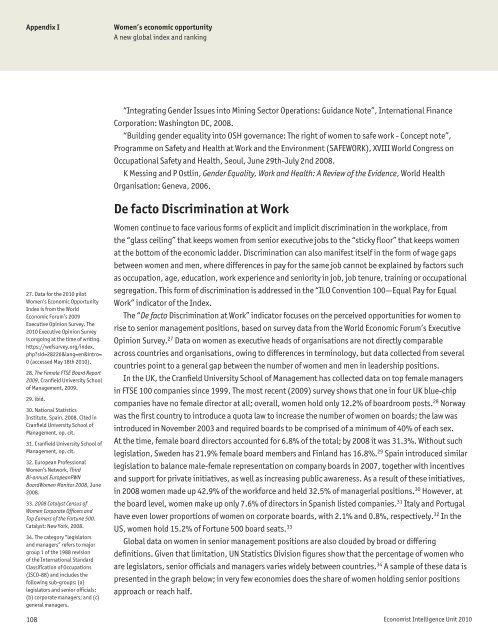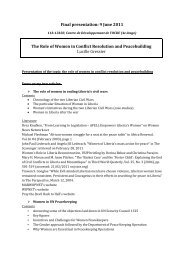Women's Economic Opportunity Index - Economist Intelligence Unit
Women's Economic Opportunity Index - Economist Intelligence Unit
Women's Economic Opportunity Index - Economist Intelligence Unit
- No tags were found...
You also want an ePaper? Increase the reach of your titles
YUMPU automatically turns print PDFs into web optimized ePapers that Google loves.
Appendix IWomen’s economic opportunityA new global index and ranking“Integrating Gender Issues into Mining Sector Operations: Guidance Note”, International FinanceCorporation: Washington DC, 2008.“Building gender equality into OSH governance: The right of women to safe work - Concept note”,Programme on Safety and Health at Work and the Environment (SAFEWORK), XVIII World Congress onOccupational Safety and Health, Seoul, June 29th-July 2nd 2008.K Messing and P Ostlin, Gender Equality, Work and Health: A Review of the Evidence, World HealthOrganisation: Geneva, 2006.27. Data for the 2010 pilotWomen’s <strong>Economic</strong> <strong>Opportunity</strong><strong>Index</strong> is from the World<strong>Economic</strong> Forum’s 2009Executive Opinion Survey. The2010 Executive Opinion Surveyis ongoing at the time of writing.https://wefsurvey.org/index.php?sid=28226&lang=en&intro=0 (accessed May 18th 2010).28. The Female FTSE Board Report2009, Cranfield University Schoolof Management, 2009.29. ibid.30. National StatisticsInstitute, Spain, 2008. Cited inCranfield University School ofManagement, op. cit.31. Cranfield University School ofManagement, op. cit.32. European ProfessionalWomen’s Network, ThirdBi-annual EuropeanPWNBoardWomen Monitor 2008, June2008.33. 2008 Catalyst Census ofWomen Corporate Officers andTop Earners of the Fortune 500.Catalyst: New York, 2008.34. The category “legislatorsand managers” refers to majorgroup 1 of the 1988 revisionof the International StandardClassification of Occupations(ISCO-88) and includes thefollowing sub-groups: (a)legislators and senior officials;(b) corporate managers; and (c)general managers.De facto Discrimination at WorkWomen continue to face various forms of explicit and implicit discrimination in the workplace, fromthe “glass ceiling” that keeps women from senior executive jobs to the “sticky floor” that keeps womenat the bottom of the economic ladder. Discrimination can also manifest itself in the form of wage gapsbetween women and men, where differences in pay for the same job cannot be explained by factors suchas occupation, age, education, work experience and seniority in job, job tenure, training or occupationalsegregation. This form of discrimination is addressed in the “ILO Convention 100—Equal Pay for EqualWork” indicator of the <strong>Index</strong>.The “De facto Discrimination at Work” indicator focuses on the perceived opportunities for women torise to senior management positions, based on survey data from the World <strong>Economic</strong> Forum’s ExecutiveOpinion Survey. 27 Data on women as executive heads of organisations are not directly comparableacross countries and organisations, owing to differences in terminology, but data collected from severalcountries point to a general gap between the number of women and men in leadership positions.In the UK, the Cranfield University School of Management has collected data on top female managersin FTSE 100 companies since 1999. The most recent (2009) survey shows that one in four UK blue-chipcompanies have no female director at all; overall, women hold only 12.2% of boardroom posts. 28 Norwaywas the first country to introduce a quota law to increase the number of women on boards; the law wasintroduced in November 2003 and required boards to be comprised of a minimum of 40% of each sex.At the time, female board directors accounted for 6.8% of the total; by 2008 it was 31.3%. Without suchlegislation, Sweden has 21.9% female board members and Finland has 16.8%. 29 Spain introduced similarlegislation to balance male-female representation on company boards in 2007, together with incentivesand support for private initiatives, as well as increasing public awareness. As a result of these initiatives,in 2008 women made up 42.9% of the workforce and held 32.5% of managerial positions. 30 However, atthe board level, women make up only 7.6% of directors in Spanish listed companies. 31 Italy and Portugalhave even lower proportions of women on corporate boards, with 2.1% and 0.8%, respectively. 32 In theUS, women hold 15.2% of Fortune 500 board seats. 33Global data on women in senior management positions are also clouded by broad or differingdefinitions. Given that limitation, UN Statistics Division figures show that the percentage of women whoare legislators, senior officials and managers varies widely between countries. 34 A sample of these data ispresented in the graph below; in very few economies does the share of women holding senior positionsapproach or reach half.108 <strong>Economist</strong> <strong>Intelligence</strong> <strong>Unit</strong> 2010




